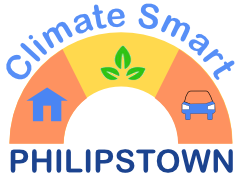BUSINESS / NON-PROFIT

There are over 100 businesses, non-profits, religious, educational and community organizations in Philipstown. Each one represents an opportunity to reduce our greenhouse gas emissions (GHGs).
FACT
Businesses and non-profits who tackle their carbon footprint not only save on energy costs, but can also boost brand loyalty and employee morale. If you are part of a Philipstown-based business or organization, here are a few things to get you started on local climate action:

-
Fill out the Philipstown Business Greenhouse Gas Survey
-
Reduce, Reuse and Recycle
-
Lower Your Energy Costs
-
Use Green Refridgerants and Appliances
-
Think in terms of a circular economy and how this action affects my workers, my consumers, my planet, and back to my business.
Climate Smart Is Good For Business
2. REDUCE, REUSE AND RECYCLE
-
Reduce food waste that's responsible for 8% of greenhouse gas emissions.
-
Reduce plastic packaging whenever possible.
-
Consider reusable take away containers
-
Can you offer quality used goods in your mix of offerings?
-
Can you include zero waste or plastic-free options
3. LOWER YOUR ENERGY COSTS
Make your workplace more energy efficient.
Making your workplace more energy efficient and running on renewable electricity means fewer GHG emissions, and better bottom line. Here’s a list to get your started:
-
The first step is to assess your workplace. The New York State Energy Research and Development Agency (NYSERDA) has several energy audit programs
-
Make the switch to LED lights
-
Install occupancy sensors indoors, and motion sensing lights outdoors.
-
Install solar on your rooftop
-
Make sure all computers and office equipment are in “stand-by” mode when not in use. Plugging equipment into energy efficiency power strips, which can be turned off when not in use.
-
Consider switching to heat pumps for heating and cooling, save energy, increase employee comfort, and reduce your carbon footprint. Visit NYSERDA for more information.
-
Consider installing an electric vehicle charger for your employees and customers, and transition company cars to electric (link to mobility page)
-
Have your landscapers switch to bi-weekly mowing and eliminate synthetic fertilizers.
4. USE GREEN REFRIGERATORS AND APPLIANCES
Both refrigerators and air conditioning units release harmful chemicals and greenhouse gases that damage the atmosphere.
The original culprits, chlorofluorocarbons (CFCs) and hydrochlorofluorocarbons (HCFCs), were responsible for tearing a hole in the ozone layer in the 1980s. While these chemicals are not in use anymore, their replacement hydrofluorocarbons (HFCs) are still 1,000 to 9,000 times more potent than CO2 in terms of climate impact. Luckily, green tech has cleaner, friendlier alternatives: GreenFreeze fridges by Greenpeace and smart refrigerators.
Introduced in the 1990s, GreenFreeze refrigerators are used globally and stay cool using naturally occurring hydrocarbons that are far less potent than HFCs and don’t break down into toxins. Unfortunately, these refrigerators are not widely available in the US since the EPA only allowed manufacturers to sell in the states starting in 2011. Smart refrigerators may be a more accessible alternative. With the purpose of reducing your electricity bill, smart refrigerators are designed to cool around your opening habits. And when your refrigerator has reached the end of its life,
It’s time to take action! For more information and advice on how to reduce your organization’s GHG emissions, contact Climate Smart Philipstown’s Business and Non-Profit Committee: climatesmartphilipstown.org csphilipstown@gmail.com
1. WE NEED YOUR HELP ESTABLISHING A BASELINE OF GREENHOUSE GAS EMISSIONS
Please fill out this survey to help us get started..



